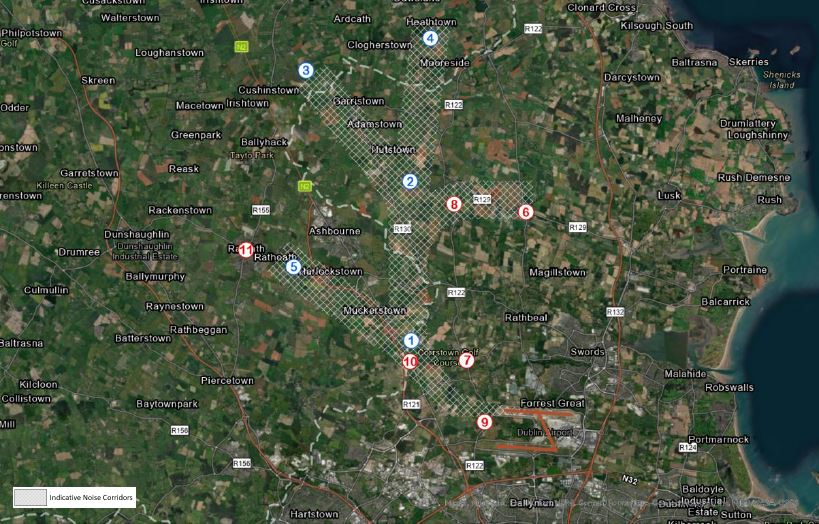As previously advised, an issue regarding North Runway’s departure flightpaths was identified which resulted in some local communities being unexpectedly overflown, for which daa again sincerely apologises. daa immediately undertook a review in consultation with the relevant stakeholders which established that some Instrument Flight Procedures, specifically the current Standard Instrument Departures (SIDs), needed to be updated to align flightpaths more closely with the information previously communicated by daa.
The revised SIDs underwent the required regulatory review and consent processes and were approved to become operational on February 23, 2023, in line with the International Civil Aviation Organisation’s Aeronautical Information Publication cycle. Flight simulations of the revised SIDs were also completed, and we now provide more details about these new flightpaths and associated indicative noise corridors.
Taking account of factors including other airfield airspace and parallel runway operations, Safety Regulations require that aircraft departing North Runway 28R will follow the new SIDs which must diverge by a minimum of 30 degrees northwest. Following this 30-degree turn, all aircraft will head towards Waypoint 1, and on passing that initial point, aircraft will then continue to climb on course to their ultimate destinations using further waypoints. A waypoint is a point on the flightpath that aircraft should flyby or fly over; for example, UK-bound flights will typically use Waypoint 1 and then 2, whilst transatlantic flights will typically use Waypoints 1, 2 and then 3.
The rate that aircraft climb will depend on aircraft type, weather conditions and load factor, so aircraft altitudes will vary. Typically, across the two main aircraft types used at Dublin Airport (Airbus A320 and Boeing 737-800), with maximum take-off weight, aircraft will reach the following typical altitudes at the waypoints and locations identified on the illustration.
| Location | | Typical Height* |
| 1 | DW128 flyby waypoint used by all 28R departing aircraft | 2,200 |
| 2 | DW129 flyby waypoint typically used by transatlantic, northerly and easterly bound aircraft | >5,500 |
| 3 | DW120 flyby waypoint typically used by transatlantic bound aircraft | 9,000 |
| 4 | DW119 flyby waypoint typically used by northerly bound aircraft | 9,000 |
| 5 | DW991 flyover waypoint typically used by southerly bound aircraft | >4,000 |
| 6 | Ballyboughal | 6,700 |
| 7 | Kilsallaghan (not overflown) | N/A |
| 8 | Oldtown | 5,250 |
| 9 | St. Margaret’s | 1,200 |
| 10 | Coolquay | 2,200 |
| 11 | Ratoath | >4,000 |
*Feet above ground level
The revised SIDs will align flightpaths more closely with the information previously communicated by daa. This means that from February 23 some areas like St. Margaret’s, Shallon and The Ward Cross will continue to be overflown as anticipated, whilst other areas like Oldtown and Ballyboughal will also continue to be overflown but at higher altitudes. Areas such as Skephubble, Kilsallaghan and Rolestown will no longer be directly overflown by jet aircraft but will still be exposed to a certain amount of aviation noise, albeit less than currently. Category A/B (turbo propeller and small jet aircraft) can continue to turn earlier than Category C/D (larger jet aircraft).
It is expected that the overall number of houses in the various noise contours will be similar to that previously communicated. However, a small number of dwellings which were previously on the verge of eligibility for mitigation measures may become eligible as a result of these revised SIDs. We intend to engage with these dwellings regarding the required mitigations as soon as possible.
To enhance tracking of aircraft using Dublin Airport, 18 new noise monitoring terminals (16 fixed and two mobile) are being added to the existing system. 10 fixed and three mobile monitors are already in place, with 12 further fixed monitors scheduled to be installed over the coming months.

